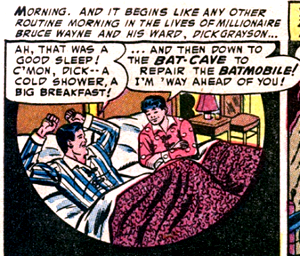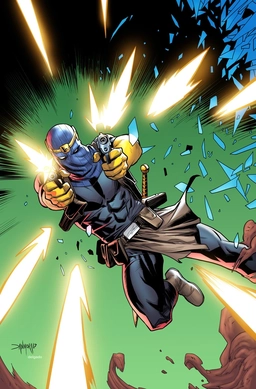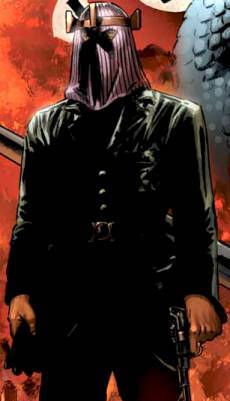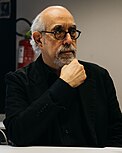
Captain America is a superhero created by Joe Simon and Jack Kirby who appears in American comic books published by Marvel Comics. The character first appeared in Captain America Comics #1, published on December 20, 1940, by Timely Comics, a corporate predecessor to Marvel. Captain America's civilian identity is Steven "Steve" Rogers, a frail man enhanced to the peak of human physical perfection by an experimental "super-soldier serum" after joining the United States Army to aid the country's efforts in World War II. Equipped with an American flag–inspired costume and a virtually indestructible shield, Captain America and his sidekick Bucky Barnes clashed frequently with the villainous Red Skull and other members of the Axis powers. In the final days of the war, an accident left Captain America frozen in a state of suspended animation until he was revived in modern times. He resumes his exploits as a costumed hero and becomes leader of the superhero team the Avengers, but frequently struggles as a "man out of time" to adjust to the new era.

The Red Skull is the alias of several supervillains appearing in American comic books published by Marvel Comics. Created by France Herron, Jack Kirby, and Joe Simon, the character first appeared in Captain America Comics #1, in which his secret identity is revealed to be George Maxon. It would later be retroactively established that Maxon was merely a decoy who was working for the real Red Skull, Johann Shmidt. Other individuals, including Albert Malik and Shmidt's own daughter Sinthea, have also adopted the Red Skull persona.

The Falcon is a superhero appearing in American comic books published by Marvel Comics. The character was introduced by writer-editor Stan Lee and artist Gene Colan in Captain America #117 and was the first Black American superhero in mainstream comic books.
Bucky is the name used by several different fictional characters appearing in American comic books published by Marvel Comics, usually as a sidekick to Captain America. The original version was created by Joe Simon and Jack Kirby and first appeared in Captain America Comics #1, which was published by Marvel's predecessor, Timely Comics. Following the apparent death of the hero James "Bucky" Barnes, the Bucky nickname and costume have been used by various heroes including: Fred Davis, Jack Monroe, Rick Jones, Lemar Hoskins, and Rikki Barnes. For a time, a child looked after by Jack Monroe was named "Bucky," but she was later adopted and given the name Julia Winters.

Sharon Carter is a character appearing in American comic books published by Marvel Comics. Created by Stan Lee, Jack Kirby, and Dick Ayers, the character first appeared in Tales of Suspense #75. Sharon Carter is a secret agent and an ex-field agent of S.H.I.E.L.D. under Nick Fury. She is also a love interest of the superhero Captain America / Steve Rogers. Sharon Carter was originally the younger sister of Peggy Carter. She was later retconned as Peggy's grand-niece because of the unaging nature of comic book characters.

Nomad is the name of several fictional characters appearing in American comic books published by Marvel Comics. The Nomad name and costume were created by writer Steve Englehart and artist Sal Buscema as an alternate identity for the original Captain America, Steve Rogers, in Captain America #180.

Betsy Ross is a character appearing in American comic books published by Marvel Comics. Created by Joe Simon and Jack Kirby, the character first appeared in Captain America Comics #1. Betsy Ross is Captain America's early love interest and supporting character in American comic books published by Marvel Comics during the 1930-1940s period known to historians and collectors as the Golden Age of Comic Books. She then debuted as the superheroine Golden Girl in Captain America Comics #66.

Captain America is a 1990 American superhero film based on the Marvel Comics superhero of the same name. It is directed by Albert Pyun and written by Stephen Tolkin, from a story by Tolkin and Larry Block. It stars Matt Salinger in the title role and Scott Paulin as his nemesis the Red Skull, with Ronny Cox, Ned Beatty, Darren McGavin, Francesca Neri, Michael Nouri and Melinda Dillon. The film produced by Menahem Golan for the now-defunct 21st Century Film Corporation

In comics, LGBT themes are a relatively new concept, as lesbian, gay, bisexual, and transgender (LGBTQ) themes and characters were historically omitted from the content of comic books and their comic strip predecessors due to anti-gay censorship. LGBT existence was included only via innuendo, subtext and inference. However the practice of hiding LGBT characters in the early part of the twentieth century evolved into open inclusion in the late twentieth and early twenty-first centuries, and comics explored the challenges of coming-out, societal discrimination, and personal and romantic relationships between gay characters.

Sinthea Shmidt is a supervillain appearing in American comic books published by Marvel Comics. Created by J. M. DeMatteis writer and artist Paul Neary, the character first appeared in Captain America #290. Shmidt is the daughter of the Red Skull and an antagonist of the superhero Steve Rogers / Captain America. She has occasionally used the codenames Sin and Mother Superior. She is also the leader of the Sisters of Sin and an ally of Hydra.

Baron Blood is the name of several supervillains appearing in American comic books published by Marvel Comics. The first incarnation of Baron Blood, John Falsworth, first appeared in The Invaders #7, who has been part of the superhero Captain America's rogues gallery since World War II. The second incarnation, Victor Strange, debuted in Doctor Strange, Sorcerer Supreme vol. 3 #10. The third incarnation, Kenneth Crichton, made his first appearance in Captain America #253.

Helmut Zemo is a character appearing in American comic books published by Marvel Comics. Created by Roy Thomas, Tony Isabella and Sal Buscema, the character first appeared in Captain America #168. Helmut Zemo is the son of Baron Heinrich Zemo and the thirteenth Baron Zemo in his family lineage. He is a recurring adversary of the Avengers, especially the superhero Steve Rogers / Captain America. The character has also been known as Citizen V at various points in his history.

Heinrich Zemo is a supervillain appearing in American comic books published by Marvel Comics. The character was created by Stan Lee and Jack Kirby, and first made a cameo appearance in The Avengers #4, before officially being introduced in The Avengers #6. He was retroactively added into the history of Captain America upon the superhero's reintroduction in the Silver Age of Comics two issues prior. Baron Zemo is a Nazi scientist and the founder and original leader of the Masters of Evil, and is commonly depicted as one of the greatest enemies of Captain America and the Avengers. He is the twelfth Baron Zemo in his family lineage, and his legacy is continued by his son, Helmut Zemo.

The Destroyer is the name of three fictional superheroes appearing in American comic books published by Marvel Comics. The original incarnation was created by writer Stan Lee and artist Jack Binder and first appeared in Mystic Comics #6, being one of Lee's earliest creations during the Golden Age of Comic Books.

James Buchanan "Bucky" Barnes is a character appearing in American comic books published by Marvel Comics. Originally introduced as a sidekick to Captain America, the character was created by Joe Simon and Jack Kirby and first appeared in Captain America Comics #1. Barnes' original costume and the Bucky nickname have been used by other heroes in the Marvel Universe over the years.

Jack Monroe is a fictional superhero appearing in American comic books published by Marvel Comics. The character was originally introduced as third sidekick under the Bucky identity, initially treated as the original Bucky Barnes before being retconned as a separate character, and later the most well-known incarnation of Nomad.

Samuel Thomas "Sam" Wilson is a fictional character portrayed by Anthony Mackie in the Marvel Cinematic Universe (MCU) media franchise, based on the Marvel Comics character of the same name and known commonly by his original alias, the Falcon. Wilson is initially depicted as a veteran United States Air Force Pararescueman who specializes in the use of an advanced jet pack with articulated wings. A skilled combatant and tactician, Wilson becomes a close friend of Steve Rogers after assisting him during the Hydra uprising, later being recruited by him to join the Avengers.

James Buchanan "Bucky" Barnes is a fictional character portrayed by Sebastian Stan in the Marvel Cinematic Universe (MCU) media franchise—based on the Marvel Comics character of the same name. Barnes is childhood best friends with Steve Rogers and serves alongside him in the Howling Commandos during World War II. Barnes is seemingly killed in action, but is actually captured by elements of Hydra within the Soviet Union. He is brainwashed and transformed into a super soldier with a metal arm known as the Winter Soldier. In their quest for world domination, Hydra uses a programmed Barnes as an assassin throughout the 20th century.

In fandom, Stucky is the pairing of Steve Rogers and James Buchanan "Bucky" Barnes, fictional characters who appear in comic books and related media produced by Marvel Comics. The pairing is a manifestation of shipping, a phenomenon in fandom wherein individuals create fan works that depict a romantic or sexual relationship between two characters whose relationship in the source material is typically neither romantic nor sexual; Stucky is an example of slash, a genre of fan works that focus on same-sex characters. In accordance with shipping naming conventions, Stucky is a portmanteau of "Steve" and "Bucky".




















